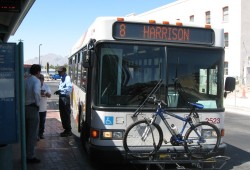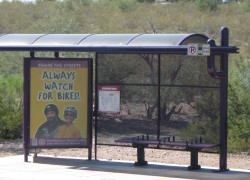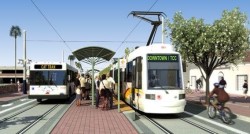Intermodal Transportation Planning and Development: A Closer Look at Linking Transit to Bicycling and Walking
Tucson, Arizona
Source: Pedestrian and Bicycle Information Center (PBIC)
Problem
Can communities reduce the length or number of car trips by making better intermodal connections? An intermodal trip involves more than one type of transportation, such as walking and transit, bicycling and transit, or driving and transit. Communities interested in offering commuters more transportation choices in an age of rising gas prices and concern about climate change can learn from the plans, policies and programs implemented by the City of Tucson.
Background
The Tucson region, population 1 million, makes up the majority of Pima County's population. It has evolved into a thriving metropolitan area over the last four decades. Homogenous land-use zoning, one-story planned housing developments, strip malls and lots of cars have all contributed to urban sprawl. The average one-way work commute in Pima County is now 13 miles; the mode split is 74 percent single-occupant driving, 14.7 percent carpooling, 2.6 percent walking, 2.5 percent transit, 3.7 percent work at home, and 2.7 percent other modes, including bicycling (Pima Association of Governments Regional Transportation Plan 2030).
City leaders and citizen advocates support intermodal planning and development in the greater Tucson community to develop a more balanced mode share. Tucson's regional transit system, Sun Tran, has grown significantly since it was established in 1973. It now provides over 18 million passenger trips a year on a network of 505 route miles, using a fleet of 203 alternative-fueled buses. Some routes offer service from 4:00 a.m. to midnight on weekdays; all local (non-express) routes operate on weekends; and seven of the 38 routes provide 10 to 15-minute service Monday through Friday. Ridership increased 31 percent between fiscal years 2002 and 2007. April 2008 ridership grew 14.7 percent compared to April 2007. The system continues to expand as part of the 20-year Regional Transportation Authority (RTA) plan funded with a one-half cent countywide sales tax.
Solution
Tucson has made many gradual improvements to the Sun Tran system in an effort to improve intermodal connections.

Bicycle racks on buses
All buses have bicycle racks that hold two bicycles. The Bikes On Bus program is so successful that staff stopped promoting it because the racks are often full and riders are turned away. Sun Tran reports 27,000 bicycle boardings in an average month. This program has given some people the opportunity to attend college and hold a steady job. Drivers report that cyclists may ride ten miles to the nearest bus stop to catch the bus; this option was not possible years ago.
Accessible buses
One of the city's goals is to decrease rider dependence on paratransit service by making the fixed routes more accessible for people with disabilities. Sun Tran's entire bus fleet is ADA-accessible, providing regionwide travel for wheelchair users and anyone with limited mobility. All new buses are low-floor vehicles with wheelchair ramps that have cam mechanisms to reduce slopes for easier ingress and egress. Accessing the bus at some of Tucson's outlying roads is still challenging because slope and missing curbs present potential or actual barriers.
City staff recently drafted a new policy regarding Segway use on buses. The local Segway dealer asked for clarification to ensure these devices are permitted on public buses as a medical mobility device. The policy does allow Segway users to board under certain conditions to ensure a safe transition. Although no one has tried to board yet, Segways offer another multi-modal option for commuters.

Tucson earned 218,500 in 2007 from these advertising bus shelters.
Photo: Tom Fisher
Bus shelters
The city contracts with a private advertising company to provide clean, modern and functional bus shelters to attract more transit riders. The company provides all the shelters and concrete pads and maintains them in exchange for ad revenue. (The city earns a percentage of the revenue which goes directly into the general fund.) Some shelters have solar-powered tops to supply lighting for ad displays.
One of the principal benefits of the program is that bus stops are upgraded to ADA standards with new concrete pads, sidewalk connections to nearby intersections, wheelchair passenger shade, lighting and route information. The city also plans to add 100 bicycle racks at high-volume bus stop locations. These improvements encourage multi-modal commutes as transit becomes a more attractive option for drivers, cyclists, and pedestrians.
Park-and-rides
Park-and-rides are another major component of successful intermodal systems. Sun Tran serves 22 facilities, of which four are owned by the city and the rest are located on private properties (usually shopping centers) through agreements with the owners. The city-owned facilities have 50 to 100 vehicle parking spaces as well as both bicycle racks and bicycle lockers that the general public can rent for $2 per month. The lockers offer another option for multi-modal commuters who cannot bring their bicycles on the bus.
Six new regional park-and-rides (for bicycles and vehicles) will be built within the next two years as part of the 20-year RTA plan. They will be located in outlying areas currently not served by Sun Tran or other fixed route systems. All will be fed by new express routes traveling to central Tucson, in a hub and spoke arrangement. The facilities will offer basic amenities: shelters, lighting, landscaping, video security, route information, and bicycle racks and lockers. All park-and-rides are free and open to the public. The city is currently collaborating with a private developer to integrate a park-and-ride into a new upscale shopping center on the city's growing southeast side.
Transit centers
Three transit centers serve as the major hubs on the Sun Tran route network: one on the south side, one on the north side, and one in the heart of downtown Tucson. The majority of all routes converge at these hubs. Two of the centers have adjacent park-and-ride lots to accommodate long-distance commutes from the north and south. A five-level mixed-use parking garage was recently constructed next to the downtown transit center.
A new communication tool that serves and increases transit ridership is Sun Tran's real-time information display, which notifies riders when the next bus is due to arrive. Display monitors are mounted above each designated route stop at the transit centers and currently show scheduled departures. Actual departures will be displayed when the program software becomes fully operational at the end of 2008. This system will eventually be expanded to other stops as well as park-and-rides to give riders more confidence in making transfers between modes.
Ridership from small rural communities is growing due to the aging population and the high cost of gas which disproportionately affects low-income families, making seamless transfers between rural and urban fixed route systems a high priority for the region. The south-side transit center offers a designated bus bay for Pima County transit service to the Tohono O'odham Indian Reservation 60 miles west of Tucson.
The rural town of Marana route and an urban Sun Tran route both terminate in the parking lot of a home improvement store on the northwest side. The rural route schedule is specifically developed to coordinate with the Sun Tran schedule for easy transfers.
Sidewalk connections
One of the major deterrents to using transit is a lack of sidewalks that are safe, direct and easily accessible. Tucson is making up for many decades of poor planning by installing new sidewalks and ramps along major roadway corridors. A regional sidewalk study conducted in 2003 identified gaps in the pedestrian system and established priorities through an itemized list of projects. Corridors with high transit use, high commercial and residential densities, and connections to major medical centers are given priority.
The city has constructed tens of miles of new sidewalk since 2000. A new sidewalk inventory will begin in the fall of 2008 to measure progress and re-prioritize gaps in the network. Pedestrian travel has increased along these corridors as all people, including persons with disabilities, now have a safe place to walk. In terms of intermodal connections, many of the bus stops are now ADA-accessible from the nearest intersection where once wheelchair users or parents with strollers were forced to travel in the vehicle lane.
Bikeways
With over 700 miles of on-street lanes, shared-use paths and designated neighborhood bicycle routes, the Tucson region has one of the most extensive bikeway networks in the U.S. While the regional mode split for bicycle use is very low (2.1 percent), central Tucson has a large population of citizens who commute by bicycle, especially near the University of Arizona campus. The year-round warm weather and the connected grid pattern of streets encourage cycling.
Several policies have contributed to the success of the bikeway network. The Tucson Department of Transportation requires that all roadway improvement projects include on-street bicycle lanes during reconstruction. The same goes for Pima County and some other jurisdictions. The region also has a network of shared-use paths along its dry rivers that are connected via underpasses and overpasses. About half of the bikeways are on major transit routes or provide direct access to park-and-rides and transit centers where bicycle parking is available.
A new trend in intermodal travel has emerged near the University of Arizona campus. Many of the 51,000 students, staff and faculty drive to the university's outlying parking lots, then commute by bicycle to campus. This is a direct result of on-campus parking that is in short supply, expensive and hard to access. About 14 percent of the entire campus population commutes by bike. Of the 25,000 who live within five miles of campus, about 23 percent commute by bike.
Downtown Intermodal Center Master Plan
In 1999, Tucson adopted the Downtown Intermodal Center Master Plan in an effort to connect regional transit services and stimulate downtown revitalization. The plan focuses on the historic Union Pacific train depot and adjacent parcels where many transit services now converge. The depot, renovated to its 1941 design, currently houses Amtrak and rental car agencies, as well as several other downtown offices.
Future depot plans include a proposal for intercity rail service to Phoenix, which voters will decide in November 2008 when they consider a statewide comprehensive transportation initiative. There has been much discussion of intercity rail between Tucson and Phoenix as a way to alleviate congestion on Interstate 10 and make intermodal connections between the two large metro areas. A 2035 growth study projects a future population of 8 million along this corridor between the Mexican border (65 miles south of Tucson) and Phoenix (115 miles northwest of Tucson).
The master plan also includes construction of a new Greyhound bus depot next to the historic train station to offer easy transfers and sharing of taxi services. Sun Tran's downtown transit center is just across the street, as is the hub for the free downtown shuttle service known as TICET.

A rendering of future intermodal connections on the University of Arizona campus. Note the bicycle lanes on each side of the road.
Image: Tucson Department of Transportation
Modern streetcar system
Tucson recently began planning a four-mile modern streetcar system to link the University of Arizona campus with downtown and Rio Nuevo, a major infill project west of downtown. The streetcar will serve as the backbone of the regional transit system with connections between fixed bus routes, circulator shuttles, bikeways, park-and-rides, and pedestrians within the corridor. Bicycles will be allowed on the streetcars.
The future streetcar system is also a key component of the Downtown Intermodal Center Master Plan. The line will pass by the southern edge of the downtown transit center, offering easy transfers to Sun Tran, Amtrak, TICET, and large downtown parking garages. Investors are now gearing up to build high-density mixed use projects adjacent to the intermodal center. This shows that well-designed multi-modal transportation facilities offer valuable services that attract new types of development.
Regional collaboration
The Regional Transportation Authority coordinates all Tucson area public transit services by hosting a Transit Working Group each month. The group is charged with developing a seamless and cost-effective intermodal system. This demanding task requires representatives from each agency to think beyond their own interests and focus on the greater good of the transit-riding public.
The transit working group is currently developing a fare collection system that will integrate all fixed route services using a computerized card-reading format. Users will be able to transfer easily from one service to another and in most cases for free. Transit agencies will be able to track daily ridership, revenue and user payments with relative ease. This information can be used to analyze multi-transit and multi-modal trips throughout the region.
Encouragement
The Travel Reduction Program is a regional program sponsored by the Pima Association of Governments (PAG). It's a combination of alternate modes programs that are offered to major employers as well as the general public to encourage more carpooling, bicycling, transit use and telecommuting. Program details are available at http://www.pagnet.org/Default.aspx?tabid=220.
Result
Several investments have contributed to the success of intermodal travel in Tucson, while several have yet to be tested. The new Sun Tran buses with state-of-the-art wheelchair ramps and bicycle racks are simple but effective tools to make commutes easier. Solid data supports this case — and the frequent sight of overcrowded racks.
The bus shelter program successfully appeals to riders who are concerned about safety and comfort. Sun Tran's 10-minute frequencies entice new riders to the system by reducing wait times. Connections between major bikeways and transit centers are another important component of intermodal transportation system success. The installation of new sidewalks and ramps establishes basic connections to bus stops. Each of these investments is easy to implement as long as funding is available.
Probably most discouraging is that the park-and-rides that were once heavily used in the late 1980s and early 1990s are now only 10 to 20 percent occupied daily. This may have to do with a combination of causes: a population shift that no longer supports downtown express bus service, concerns about personal vehicle theft, limited amenities, and a lack of interest in the locations where there is no retail activity. City staff will continue to study this issue to ensure future facilities are highly utilized.
The Intermodal Depot Center is still under development, as is the four-mile modern streetcar system. It is hard to know if transfers between the various modes — Greyhound, Amtrak, Sun Tran and the modern streetcar — will meet expectations. But one thing is certain: gas prices are rising and the need for more transportation options grows every day. Connections between modes are more significant than ever before.
Cost
Tucson pays for intermodal improvements through a variety of sources:
- Sidewalks are funded through the RTA as well as major roadway projects using state gas taxes.
- Bikeways are funded through the RTA, major roadway projects, and federal Transportation Enhancements. The City of Tucson mandates the inclusion of bicycle lanes as a normal feature of major roadway improvements and re-striping projects where adequate right-of-way is available.
- Bus shelters are funded through ad revenues provided by the ad company.
- Bicycle racks on buses are funded using Federal Transit Authority grants and RTA money for bus purchases. The key is to make a commitment to funding the racks as if they are a standard feature that needs to be included with all bus purchases. Each racks costs about $500, not including installation.
- The costs of the streetcar project and elements of the downtown intermodal center are not yet determined.
Websites
Pima Association of Governments 2030 Regional Transportation Plan, 2006:
http://www.pagnet.org/Programs/TransportationPlanning/PlansandPrograms/RegionalTransportationPlanandStudies/2030RegionalTransportationPlan/tabid/379/Default.aspx
The streetcar project details (including a video simulation) are available at http://www.tucsontransitstudy.com/
Contact
Tom Fisher
Project Manager, Transit Services Division
City of Tucson
149 N. Stone, 2nd Floor
Tucson, AZ 85726
(520)791-5883
tom.fisher@tucsonaz.gov
Image Sources
Tom Fisher
Tucson Department of Transportation




